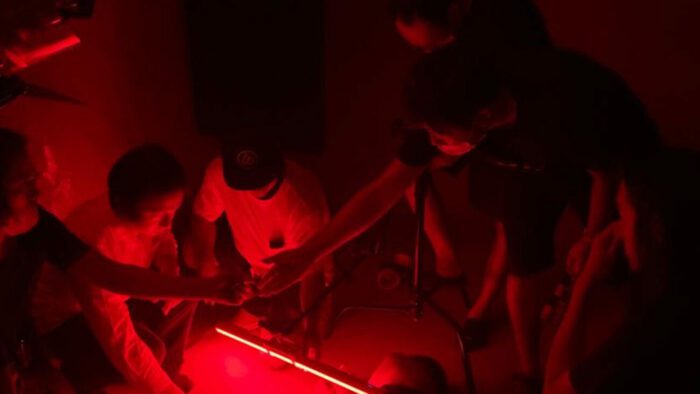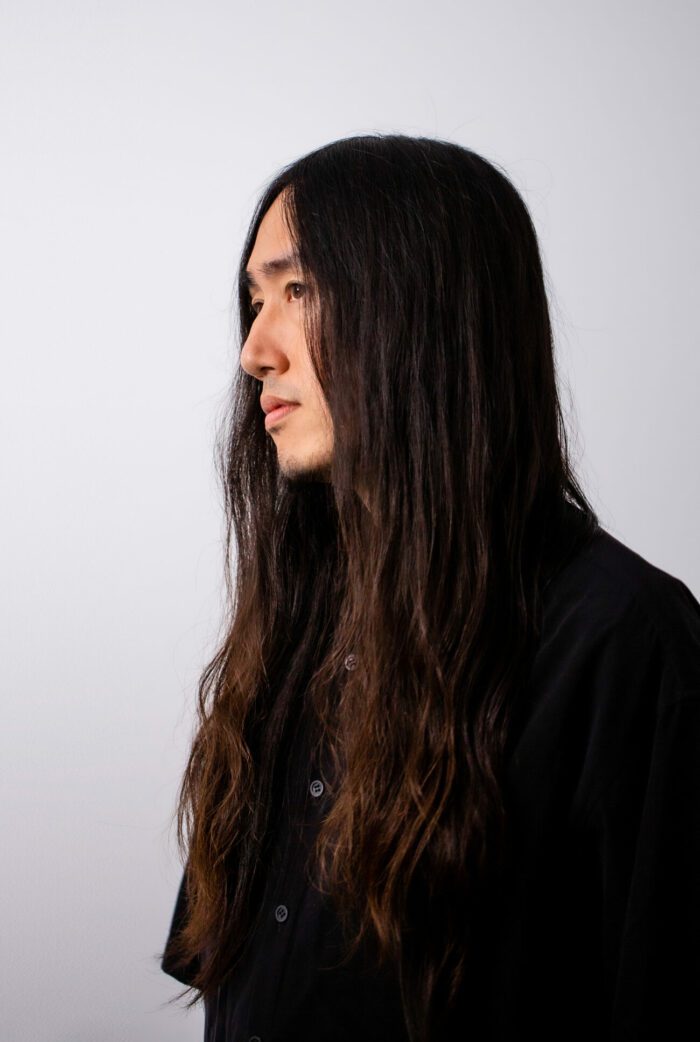Keishi Kondo’s film New Religion was the FrightFest feature which truly blew me away. I just couldn’t find the words, beyond “beautiful” and “mesmerizing,” and I don’t think my editor would have been happy with an article made up of those two words repeated several hundred times. So I sent out the inquiry for an interview instead, thinking Keishi’s insight would perhaps be as rich as the film itself. He chose to include Satoshi Oka, the actor who played Oka, the intriguing photographer in New Religion; and colleague Anne Martin to assist with translation.
I started by asking about Keishi’s career that led up to New Religion. He studied filmmaking at university; and then after graduating worked as a freelancer, making music videos and corporate videos. Keishi resumed filmmaking in 2020 with a short (See you again) and now New Religion, his first feature film.
All three of my guests have day jobs in a company making promotional videos for other businesses, and it was through this work that Keishi selected Oka for his film role. This was a relatively small role, compared to that of Miyabi, but it was pivotal: Keishi chose to bring him for our interview because, without the gravitas that he brought to it, the film would never have come to be. In fact, the script started with devising Oka’s character. I asked Oka whether he had been involved in developing that character, as it seemed very much his; but no: rather he was a source of Keishi’s inspiration, and Keishi wrote the character (and then the full story) from there.
Oka’s character had a very strong presence in the film, despite saying very little. I asked what approach he used to achieve that. Keishi’s view is that Oka (in the film) is like a god or a devil, and so Oka tried to evoke a more-than-human degree of confidence for his character To do that, Oka told me that throughout the shoot, he tried not to have any feeling or anything like humanity.

Even having watched New Religion to the end (and loved it), I had been puzzled by the choice of the title; so I asked Keishi to explain. “It is not about any traditional religion, like Christianity or Buddhism,” he told me, “but rather, I had to use this title because it is related to the social problem which Japan has. We have Buddhism and Shinto of course, but we don’t recognize them officially. Now Japanese economy is in decline and Japan used to be a very strong country; we were superior to the United States and the British, but weak nowadays. So we cannot believe in any religion or any economic power: we feel like we have nothing left to our society, so we have to make our own religion to survive this situation.”
Interesting insight, for sure, but I still struggled to see how it related to the film’s content or plot. To me, that was all about mortality and the nature of human bodies. “In the film,” Keishi continued, “she has been searching for her daughter, and finally she recognizes that her daughter is an illusion; she realizes that she herself is empty. This is kind of a metaphor of Japanese people.” It’s eye-opening to think back on the film and see it as a reflection of how its writer sees his country.
Keishi told me he didn’t want to make a film about one theme alone, but instead, New Religion can be seen on several different levels; a complex story with a lot of themes. The title does not have one single meaning for the film, but can be interpreted by the viewer.

Interpretation was something I had intended to ask about, especially in the context of symbolism. For example, I couldn’t help but wonder if the moths had some significance that was beyond me. The entity of the moth was inspired by a butterfly dream which was made by the Chinese philosopher Zhuangzi. At first, it seemed Keishi had simply decided to use them in the story without quite grasping why when the inspiration came to him about two months before making the film; but when he had written the whole script, their presence made sense.
New Religion had a terrific haunting, almost hypnotic mood at times; partly from the cinematography and also the music. I asked Keishi whether he gave the three composers clear instructions or left it up to them how to interpret the script. “The main composer was Zeze Wakamatsu,” Keishi told me. “I explained my concept and how sometimes the brief was very abstract and sometimes very precise. Such as ‘at this cut you should put a gigantic industrial sound in there.’” He showed the second composer, Akihiko Matsumoto, a Kubrick movie and asked for something along those lines. The third one, Abul Mogard was selected because Keishi already liked that composer’s music.
To me, New Religion spoke a lot about parental grief, but Keishi had mentioned layers to the film, and how it can be open to interpretation and so I asked whether there was a message for the audience to take away from it. There was no message as such, but rather he had wanted to create a movie about his own experience of life, and one which is like a mirror: everyone who watches it may have a different experience, depending on what their lives have involved; it could be a sad movie or a horror movie. If anything, the message is that everyone’s responses depend on the experiences they have had.

I wondered if this applied to the cast too. Oka saw his role as someone removed from emotion and I asked whether that changed as the film progressed, whether it had become difficult to maintain that reserve. It wasn’t difficult, because he created a character different from himself, and he was able to dissociate himself from that character.
I had seen New Religion described as “A sci-fi movie without sci-fi gadgets.” I asked Keishi whether this was his description and whether he really saw it as sci-fi. (To me, it was a somber horror that brought to mind Pulse.) His view is that depending on the audience, it can be seen as a horror movie or a science fiction movie; he is happy that everyone might have their own impression.
New Religion has had an excellent reception across a number of festivals by now. A distribution deal for Europe is looking positive, so it will hopefully reach a wider audience next year.
Next, Keishi Kondo is working on a queer horror film, about a conflict between a gay couple…with the addition of Cthulhu mythos vibes. “It will be a bit like Carpenter’s The Thing,” Keishi told me.
New Religion had its world premiere at Arrow Video FrightFest in August 2022.


